Political Interest Down from ’94
A sharp decline in the number of Americans tuned in to government and public affairs offers new evidence that the November election may not spark much interest. Indeed, just 9% of Americans are following news about candidates and elections in their states very closely. Interest in the elections is lackluster even in states where primary elections were held the very week of the poll — only 10% of respondents in states with a June 2 primary were following news about candidates and elections very closely.

Just 36% of all Americans say they follow politics and government most of the time — a significant drop from 46% in July 1994. And this may be telling: interest in public affairs was particularly high in the summer before the 1994 elections, and turnout that year was higher than the two previous midterm elections. Today, interest in politics is lower than in 1990 (39%), which had the lowest voter turnout in the post-World War II era.
The falloff in attention to government and public affairs has been broad based, with the percentage of Americans following politics most of the time dropping among every major demographic group. The decline is also bipartisan, although Republicans remain slightly more attentive than Democrats. Today, 44% of Republicans say they follow what’s happening in government most of the time, down from 54% in 1994. The share of Democrats following politics has fallen from 44% to 37%.
At the same time, more direct measures of voter interest in the election are comparable to past years. Five months before the election, there is no decline from previous years in the number of registered voters who say they plan to vote in November.
Cynicism, Not Good Times, Drives Non-Voting
Americans who say they don’t plan to vote this year point to cynicism about elections as a reason for not always voting more than they point to a lack of concern about national problems. Among those who do not plan to vote, 51% cite “voting doesn’t really change things” as an important reason why they do not always vote. Some 40% of those who are not planning to vote say a lack of interest in politics is an important reason, while 37% cite the absence of major national problems.
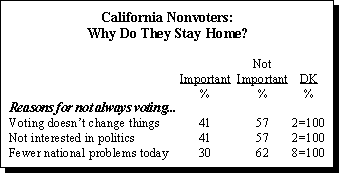
These sentiments are echoed by California residents who did not vote in the state primary this month.1 Fully 41% of those who said they did not vote cite their sense that voting doesn’t change things; another 41% say a lack of interest in politics is a reason why they don’t always vote. In contrast, just 30% say they sometimes don’t vote because “there are fewer major national problems these days.”
The Horse Race
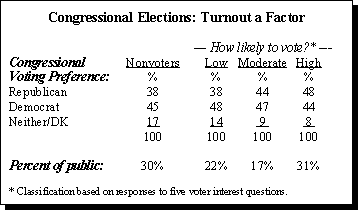
The race for control of Congress has tightened considerably over the last two months. In March, a Pew survey had the Democrats leading the Republicans in the generic House ballot measure by a 52%-40% margin. The two parties are now in a statistical dead heat. And when the sample is limited to the most probable voters, House Republicans enjoy a small 48%-44% lead.2
Democrats have lost considerable support in recent months among white women and people over age 50. White women now favor Republicans over Democrats by a narrow 46%-42% margin. In March, they were more inclined to vote Democratic — 52% vs. 40% Republican. The Democrats’ most loyal supporters remain non-whites and those with lower levels of income and education.
In addition to the generic ballot figures, the GOP can take comfort in waning anti-incumbent sentiment. Today, only 20% of Americans completely agree that it is time for Washington politicians to step aside and make room for new leaders. More than one-third (34%) felt this way in the summer of 1994, just prior to the Republicans’ historic takeover of the House and Senate. The current figures mirror those found in the spring of 1990 — months before a status quo election that saw 96% of incumbents reelected to the House of Representatives.
At this point, large national issues are not a driving force behind voter preferences. Overall, a plurality of Americans (37%) say state and local issues will make the biggest difference in how they vote for Congress. Three-in-ten (32%) say a candidate’s character and experience will make the difference; 22% say national issues.
Clinton and Congress
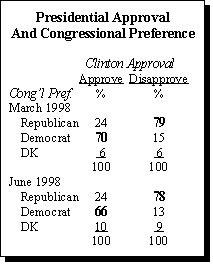
The relationship between presidential approval and congressional voting intentions remains robust. Fully 66% of those who approve of the job Clinton is doing say they will vote Democratic in their House district; 78% of those who disapprove of Clinton say they will vote Republican. While congressional preferences have shifted somewhat since March, this relationship remains stable — suggesting that if Clinton’s approval ratings move significantly up or down, congressional preferences may follow accordingly.
In spite of this strong relationship, most voters (57%) say Bill Clinton will not be a factor in how they vote for Congress. Only one-in-five say their vote for Congress will be a vote for Clinton, nearly as many (18%) say theirs will be a vote against the President.
Voters are more inclined to say party control of Congress will be a factor in how they vote this fall. Fully 45% say this will be a factor in their vote; 51% say it will not. Republicans and Democrats are equally likely to cite partisanship as a factor in their congressional vote (53%); Independents are much less likely to care about this (28%).
The top issues on Americans’ minds this election season are education, taxes, Social Security, and crime. When asked what one issue they would most like to hear the candidates in their state or district talk about, one-in-five respondents named education, 12% named taxes, 8% Social Security, and 8% crime. Republicans and Democrats place equal emphasis on education (21% and 22%). However, Republicans are much more interested than Democrats in hearing about taxes (19% vs. 8%). Not surprisingly, voters place much less emphasis on the economy than was the case leading up to the last two presidential elections.
HMOs: A Hot Button Issue

Potential regulation of health maintenance organizations (HMOs) is one issue that a clear majority of the public sees as very important to both the country and themselves personally. When asked to rank a series of issues, 69% say the debate over HMO regulation is very important to the nation, 60% say it is very important personally.
Partisan control of Congress and campaign finance reform place a distant second and third on the American agenda. Half (51%) list the outcome of the 1998 congressional elections and partisan control of Congress as very important for the country; 47% say campaign finance is very important.
The high-profile government investigations in Washington sit at the bottom of the list of public concerns. The Justice Department’s investigation into Microsoft and Independent Counsel Kenneth Starr’s probe into the relationship between Monica Lewinsky and President Clinton are considered very important by just one-in-five Americans (21% and 18%, respectively).
Americans under age 30 — who pay less attention to news in general — rank all of the issues as less important to them personally than do Americans ages 50 and older. Generational differences are as large as 15 to 21 percentage points for partisan control of Congress, tobacco regulation, industry mergers, and the debate over HMOs.
Microsoft, Yes; Tobacco, No
In the current struggle between private industry and government regulation, Americans side with business on technology and with government on smoking. And they rate tobacco as much more important.
An overwhelming majority (95%) of the public is aware of the dispute between the government and the tobacco industry regarding the advertising and sale of tobacco products. Of those who have heard about this issue, 62% side with government; only 29% favor industry. Women and the better educated are some of the strongest supporters of the government’s case. Those who consider the effort to regulate tobacco very important support government over industry by a 71%-23% margin.
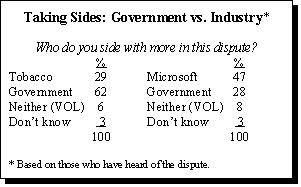
The tobacco companies maintain strong support only among Americans who smoke. Regular and occasional smokers favor industry over government by a margin of 51% to 40%. Even a majority (56%) of Republicans — traditional opponents of government regulation — side with the government over the tobacco companies.
Almost three-quarters of the public has heard about the dispute between Microsoft and federal and state governments over alleged unfair business practices. Of those, 47% side with Microsoft, compared to only 28% who side with government. The computer giant wins especially strong support from Republicans (56%).
Reforming Social Security
Americans favor both public and private measures for addressing the financial problems in the Social Security system. Support for using a potential budget surplus to stabilize the Social Security and Medicare programs increased from 32% in January to 44% in June. At the beginning of the year, Americans were divided between using a surplus for increased spending on domestic programs and making Social Security and Medicare financially sound. Now, support for spending on these entitlement programs surpasses that for domestic spending by a margin of 44% to 28%. Just 17% opt for national debt reduction; 9% would cut taxes.
In addition, among the 60% of the public that is aware of a specific proposal to reform the Social Security program, there is widespread support for allowing Americans to put a portion of their Social Security taxes into a personal savings account, by a margin of 69% to 20%. College graduates, the affluent and Republicans are the most supportive of this idea (78%, 76% and 73%, respectively); senior citizens are the least enthusiastic (57%).
The Campaign
Record political advertising budgets notwithstanding, Americans still say they learn more about candidates from news reports than from commercials. By a margin of 74% to 18%, television news reports are thought to provide a better idea of where a candidate stands on the issues. And by a margin of 62% to 29%, Americans prefer news reports when it comes to learning about what a candidate is like personally. These percentages are largely unchanged from May 1990.
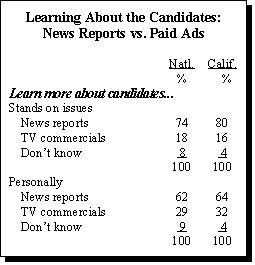
In California, where enormous sums of money were spent on political advertisements in the recent gubernatorial and Senate primaries, people agree that news reports give them a better sense of candidates than do paid advertisements. Fully 80% say news reports give them a better idea of where candidates stand on issues; 64% say the news gives them a better idea of what a candidate is like personally. Whether through news reports or TV commercials, most Americans (64%) like to have a picture of a candidate in their minds when they go to vote.
Opinions about political advertisements aside, voters acknowledge that ads are effective. Fully 63% say they often don’t become aware of political candidates until they see their advertising on television. Americans are more evenly divided over whether they get a sense of what a candidate is like personally through his or her TV commercials: 47% agree, 51% disagree. This represents a significant decrease from May 1990 when a strong majority (58%) agreed that commercials gave them a sense of what a candidate is like.
Women appreciate candidate advertisements slightly more than men — 51% agree that commercials give them a sense of what a candidate is like, compared to 43% of men. In addition, those least likely to vote in the fall elections are the most reliant on candidate ads: 32% completely agree that they often are not aware of a political candidate until they see his or her advertisements on television, compared to 16% of the most likely voters.
Americans say debates are more useful in evaluating candidates than are news reports or radio talk shows. Four-in-ten say debates are very useful for finding out about candidates running for office in their state or district; 33% find news reports very useful; 26% say the same of talk radio.
Again there are differences here between likely and unlikely voters. Those most inclined to vote favor debates over news reports by a significant margin: 42% find debates very useful vs. 28% who say news reports are very useful. Those who are the least likely to vote prefer news reports to debates: 40% find news reports very useful; 34% say the same of debates.
Thus far, the public is relatively satisfied with news coverage of this year’s elections. More than half (53%) say news organizations are giving the right amount of coverage to the 1998 congressional elections. Only 15% say there has been too much coverage; 24% say there has been too little. Evaluations of the coverage of state and local elections are similar: 49% say news organizations are giving the right amount of coverage to these contests; 17% say too much; 28% say too little.
News Interest Index
News about nuclear testing in India and Pakistan drew more interest from Americans than any other international story not involving U.S. troops in the last decade. More than one-third of Americans (36%) followed the story very closely this month, another third (34%) followed the news fairly closely. For perspective, the audience following the civil war in Bosnia very closely never topped 23%, and even when American troops were deployed as peacekeepers, interest peaked at 37% in January 1996.
Attention to bomb testing halfway around the globe reflects the public’s concern about the spread of nuclear weapons. Fully 70% of Americans said stopping nuclear proliferation should be a top foreign policy issue, ranking the matter second only to protecting U.S. jobs in a fall 1997 Pew Research Center survey.3
The story that drew the most interest this month did strike closer to home: the shooting at a high school in Springfield, Oregon. Nearly half of the country (46%) followed news of the tragedy very closely, essentially the same number that followed news about the April shooting at a middle school in Jonesboro, Arkansas (49%).
Interest in the allegations of sexual misconduct against President Clinton remains fairly steady: 28% of the public reports following the story very closely this month; 30% did so in March; 34% in early February. The public showed less interest in allegations that U.S. policy toward China was influenced by campaign contributions. Only 16% of the public followed the China story very closely, similar to the interest in past stories involving charges of campaign finance irregularities.
News of Frank Sinatra’s death drew the very close attention of 17% of the public; news about Viagra, a new drug to help overcome impotence, got similar attention from 15% of Americans. The Chrysler-Daimler merger drew the very close interest of 12% of the public.
Comparing the news interests of men and women, the Oregon school shooting sparked the most attention among women (53% followed very closely vs. 39% of men). Nuclear testing was the top story among men (43% vs. 30% of women). Men were more interested than women in allegations of sexual misconduct against Clinton (33% of men followed the story very closely vs. 24% of women), but they were no more interested in news about Viagra (15% of men and 14% of women followed the story very closely).
Republicans paid considerably more attention than did Democrats to allegations about the influence of campaign money on U.S. policy on China (25% followed the story very closely vs. 12% of Democrats), but they showed only slightly more interest than did Democrats in allegations of sexual misconduct by Clinton (34% vs. 30%). Republicans and Democrats are following news about candidates and elections in equal numbers (12% vs. 11%).